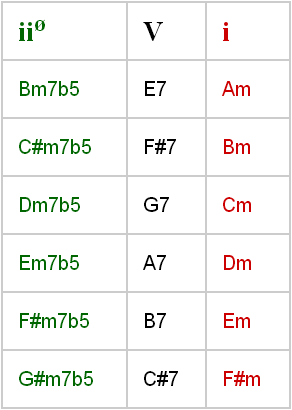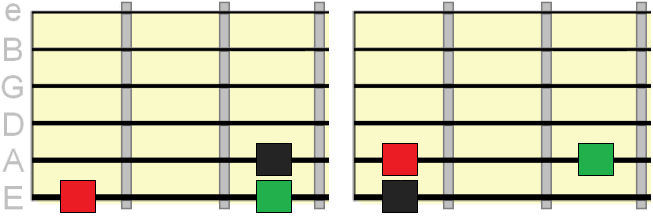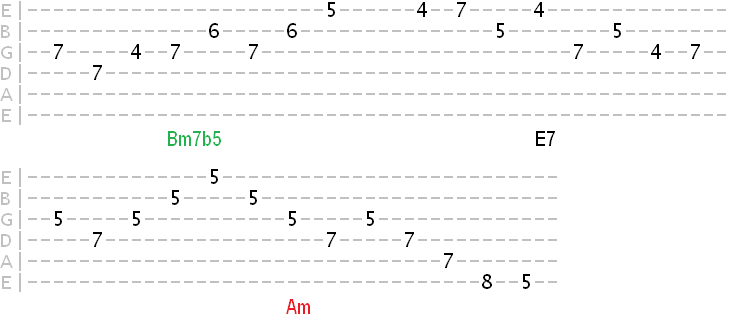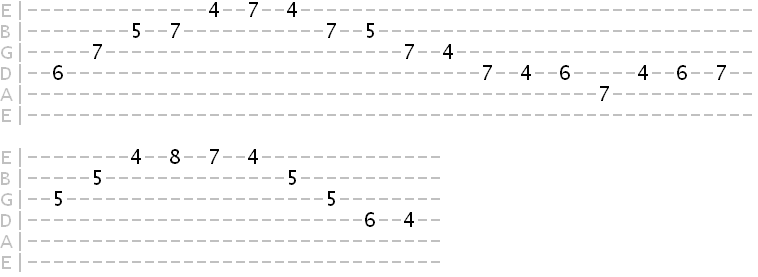Home
> Progressions
/ Theory
> Minor 2 5 1
The minor key version of 2 5 1 (numerals: iiø-V-i) performs a similar function to the more popular major key (ii-V-I), but is governed by different harmonic "rules". This lesson is about breaking down those rules so we can hear, visualize and play through it confidently and musically.
Start by watching the presentation below before moving on to the lesson, which includes ear training audio, backing tracks, licks and everything you need to jam your way through 2 5 1.
 Track 1 Chords: Bm7b5 -
E7 - Am
(right click "save as" to download)
Track 1 Chords: Bm7b5 -
E7 - Am
(right click "save as" to download)
 Track 2 Chords: Em7b5 -
A7 - Dm9
Track 2 Chords: Em7b5 -
A7 - Dm9
 Let's
start by getting to know the chord sequence so we know
where to position our fingers on the fretboard in any key.
Let's
start by getting to know the chord sequence so we know
where to position our fingers on the fretboard in any key.
Conveniently, we can visualize the ii-V-i sequence within a three-fret radius. The diagram below shows us the chord roots (colour coded as ii V i) how they would appear in different positions on the fretboard...

We can build our chord shapes (see diagrams below) on these root positions. So i is our tonic or "home" in minor keys. If the key was A minor, we'd position that 1 chord root on A, either on the 6th string (5th fret) or 5th string (12th fret or open) and then visualize the ii and V chord roots in relation to that.
6th String Root 5th String Root

This is the chord type most commonly built on the ii root in minor keys.
6th String Root 5th String Root

...but sometimes extended (especially in jazz) to flat 9 and sharp 9 dominant 7th chords...


It's also often played as an augmented 7th chord to add tension...

6th String Root 5th String Root

...but can be extended to a minor 6th...

...minor/major 7th...

...minor 7th...

...or minor 9th...

By using chord tones as the target notes of your phrases, you'll keep your solo/licks connected to the backing music. Think of it like connecting the dots to create something meaningful.
6th String Root 5th String Root



Here are some examples of this exercise (click the tabs to hear), starting with one chord tone per chord in A minor...

Here I'm arpeggiating the chord changes...

For example, in the key of A minor, A harmonic minor would cover Bm7b5, E7 and Am.
6th String Root 5th String Root


6th String Root 5th String Root


6th String Root 5th String Root


6th String Root 5th String Root


Or natural minor if the chord is a minor 7th (this is appropriate for track 2)...
6th String Root 5th String Root

Dorian is also a fine choice if the tonic chord is a minor 7th chord (again, track 2)...
6th String Root 5th String Root


And, as with all minor progressions, remember to add in some minor pentatonic and minor blues phrases occasionally.
I hope you found this lesson valuable and enjoyed jamming!
Share your thoughts...
Have any questions, thoughts or ideas about this lesson? Let us know using the comments form below.
Minor ii V i Turnaround Improvisation Tricks
The 2 5 1 turnaround has been used throughout the history of music to "bring home" (resolve) both major and minor key progressions. It's a great sequence of chords with which to work on your improvisation skills.The minor key version of 2 5 1 (numerals: iiø-V-i) performs a similar function to the more popular major key (ii-V-I), but is governed by different harmonic "rules". This lesson is about breaking down those rules so we can hear, visualize and play through it confidently and musically.
Start by watching the presentation below before moving on to the lesson, which includes ear training audio, backing tracks, licks and everything you need to jam your way through 2 5 1.
Ear Training & Backing Tracks
Feel free to download the tracks below. They play through the minor 2 5 1 sequence in two keys - A minor and D minor. One track is orchestral, the other, slightly faster (60 bpm), in a bossa nova style. Track 1 Chords: Bm7b5 -
E7 - Am
(right click "save as" to download)
Track 1 Chords: Bm7b5 -
E7 - Am
(right click "save as" to download) Track 2 Chords: Em7b5 -
A7 - Dm9
Track 2 Chords: Em7b5 -
A7 - Dm9Minor ii V i Chords
 Let's
start by getting to know the chord sequence so we know
where to position our fingers on the fretboard in any key.
Let's
start by getting to know the chord sequence so we know
where to position our fingers on the fretboard in any key.Conveniently, we can visualize the ii-V-i sequence within a three-fret radius. The diagram below shows us the chord roots (colour coded as ii V i) how they would appear in different positions on the fretboard...

We can build our chord shapes (see diagrams below) on these root positions. So i is our tonic or "home" in minor keys. If the key was A minor, we'd position that 1 chord root on A, either on the 6th string (5th fret) or 5th string (12th fret or open) and then visualize the ii and V chord roots in relation to that.
iiø chord
The ø symbol (superscript circle with a line through) means the chord is "half diminished". This is another way of saying "minor 7 flat 5" (a minor 7th chord with a flat 5th), which is why you'll often see the chord abbreviated as m7b5 (e.g. Bm7b5 or B half diminished). This chord occurs naturally in the harmonic and natural minor scales.6th String Root 5th String Root

This is the chord type most commonly built on the ii root in minor keys.
V chord
Most often this will be a dominant 7th chord...6th String Root 5th String Root

...but sometimes extended (especially in jazz) to flat 9 and sharp 9 dominant 7th chords...


It's also often played as an augmented 7th chord to add tension...

i chord
Our tonic or "home" chord. Typically a minor triad...6th String Root 5th String Root

...but can be extended to a minor 6th...

...minor/major 7th...

...minor 7th...

...or minor 9th...

ii V i Chord Patterns / Arpeggios
The first step in being able to improvise confidently and melodically through chord changes is to practice targeting chord tones. You'll later color these chord tones by wrapping scales around them.By using chord tones as the target notes of your phrases, you'll keep your solo/licks connected to the backing music. Think of it like connecting the dots to create something meaningful.
iiø chord
Here we build a half diminished (or m7b5) arpeggio pattern...6th String Root 5th String Root

V chord
Dominant 7th chord tones...
i chord
Finally, our minor triad tones. I've kept it to the basic triad because, as we learned earlier, there are 6th and 7th forms that can be used in the i position. But they all have the triad in common...
Exercises
Using the backing tracks from earlier (you downloaded them, right?), start by playing just one chord tone per chord, moving on to two and three tones per chord as you become more confident. This is known as arpeggiating the chord changes.Here are some examples of this exercise (click the tabs to hear), starting with one chord tone per chord in A minor...

Here I'm arpeggiating the chord changes...

Minor 2 5 1 Scales & Licks
Over all chords - harmonic minor
As mentioned in the video, the most convenient way of playing through minor 2 5 1 is to use the harmonic minor scale. It works over all three chords because the notes of these three chords exist within the scale. This means you can use the same scale pattern over all three chords as all three chord patterns exist within it.For example, in the key of A minor, A harmonic minor would cover Bm7b5, E7 and Am.
6th String Root 5th String Root


Alternative ii chord scale
Locrian (a staple half diminished scale - built on the 2nd degree of natural minor)...6th String Root 5th String Root


Alternative V chord scale
Try Lydian dominant for a jazzier flavour...6th String Root 5th String Root


Alternative i chord scales
As well as harmonic minor from earlier, try melodic minor (this will also work over the V chord)6th String Root 5th String Root


Or natural minor if the chord is a minor 7th (this is appropriate for track 2)...
6th String Root 5th String Root

Dorian is also a fine choice if the tonic chord is a minor 7th chord (again, track 2)...
6th String Root 5th String Root


And, as with all minor progressions, remember to add in some minor pentatonic and minor blues phrases occasionally.
I hope you found this lesson valuable and enjoyed jamming!
| Was this
helpful? Please support this site. I really appreciate it! |
Stay updated
and learn more Sign up to the newsletter for updates and grab your free Uncommon Chords book |
Share your thoughts...
Have any questions, thoughts or ideas about this lesson? Let us know using the comments form below.









